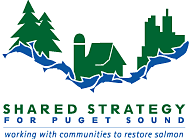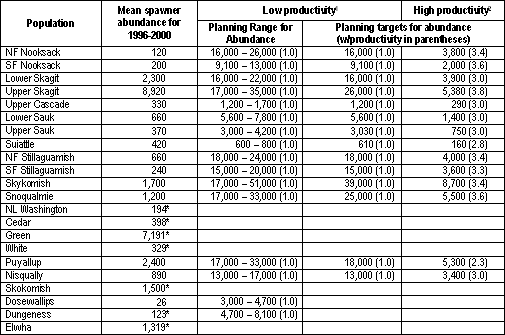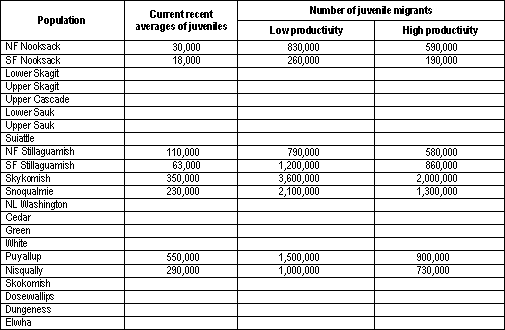|
Click here to open a printable (PDF) version of this document. Shared Strategy: A 5-step voluntary & collaborative process to develop a recovery plan for salmon in Puget Sound A key step of the Shared Strategy is the development of recovery planning ranges and targets (interim recovery goals) for the 22 individual chinook fish populations in Puget Sound. Ranges and targets will also be provided for bull trout and Hood Canal summer chum. The ranges and targets are provided here primarily to give a sense of the magnitude of the effort necessary to return chinook populations to recovered, harvestable levels. The ranges and targets also provide a common measurement for recovery planning that can be used by habitat, hatchery, and harvest managers to guide the identification and evaluation of recovery actions. These ranges and targets can facilitate discussion across watersheds as well as within habitat, harvest and hatchery programs to determine the level of recovery necessary to meet local and regional interests plus evaluate the most effective manner to achieve the long-term sustainability of fish at harvestable levels. Factors for Recovery - The Shared Strategy goal for recovery is self-sustaining populations of salmon at harvestable levels. In order to achieve sustaining populations, four interrelated factors are critical; abundance of fish at various life stages, productivity of individual populations (number of returning adults produced by the parent spawner), spatial distribution of fish and habitats, and diversity of different life traits (run timing, age structure, size, etc.) These four factors need to work together to support the health of individual populations and the whole species in Puget Sound. Current planning ranges and targets address abundance and productivity. The attached tables help illustrate the fundamental relationship between abundance and productivity factors (e.g., improving and maintaining productivity may temper the need for higher spawner abundance). Spatial distribution and diversity will be addressed later in the process and will be tailored to the characteristics of individual populations at the watershed level. Desired outcomes for spatial distribution and diversity may lead to the revision of abundance and productivity targets and ranges as the complete picture of chinook goals becomes clearer. Planning Ranges and Targets - The planning range, as determined by several technical models, provides a broad estimate of the abundance needed for a population to be viable over time. The ranges are large because of the variation in environmental conditions and uncertainty in historical information. The planning target provides a more specific measure within the range that is helpful for evaluating recovery actions in habitat, harvest, and hatcheries. The target predicts the abundance and productivity of a salmon population based on a fully functioning estuary, improved freshwater conditions, restored access to blocked habitats, and poor ocean conditions. It is important to remember that each of these numbers represents different points along the same population performance curve and that the planning target is the curve itself, not any one specific number of spawners or migrants. Magnitude of change - The planning ranges and targets were developed by scientists and policy staff over a number of months. Fully understanding how they were developed can be accomplished through more detailed briefings from Shared Strategy staff and participating scientists. The most important message to draw from the target and range is the magnitude of change from current conditions that is necessary to support self-sustaining populations. Current spawner abundance is provided in Table 1 to help illuminate the magnitude of change needed. Step 3 involves the Shared Strategy - and all of its collaborative partners - working with individual watersheds to understand the planning ranges and targets for their populations and the magnitude of change that will be needed in all life stages of the salmon population to move along the path toward recovery. Identifying changes to habitat, hatchery, and harvest actions that help achieve this magnitude of change is the essence of Step 3. What to do with the planning targets - Local governments, watershed groups, and marine groups are asked to work with the state, tribes, and federal Services to identify the actions necessary to attain the planning targets and reach consensus on how to implement those actions. This could be accomplished by first examining how existing and planned efforts in your watershed help move towards achievement of the planning targets. Following this initial assessment of current (or planned) efforts, it will then be possible to see where additional changes may be necessary to achieve the targets. For example, if current plans call for changes and improvements to habitat conditions that will increase salmon production from 800 fish to 2,000 fish, but the planning target is 3,000 fish, what additional changes could be proposed to gain this increase in fish? Restored estuary? Protected riparian habitat? Harvest restrictions? Increased hatchery production? All of these actions have important implications for the people living and working in the watershed. The advantage of working at the watershed level is that this is where it will be possible to consider those critical social, economic, and cultural implications as well as the biological needs of the fish that are unique to each watershed. For more information about planning targets - and what to do with them - for your watershed, please contact Carol MacIlroy or Margaret Duncan, Watershed Specialists, Puget Sound Salmon Forum at 206.447.3336. Table 1: Chinook Spawner Abundance Planning Targets & Ranges for Puget Sound Region (The numbers are presented for the populations for which the analysis
has been completed. State and ribal biologists are still developing
the numbers for the populations that are blank.)
* Represents spawner escapement 1987-2001. Table 2: Chinook Juvenile Migrants Planning Targets for Puget Sound Region Groups working at the watershed level have requested that planning
targets be expressed as the number of juvenile freshwater outmigrants
needed to allow the population to persist over time. Co-manager
(state and tribes) analysis provides an estimate of the number
of juvenile migrants required to maintain population viability
under recently observed adverse estuarine and marine conditions.
The numbers are presented for the populations for which the analysis
has been completed. State and tribal biologists are still developing
the numbers for the populations that are blank.
|
||||||||||||||||||||


